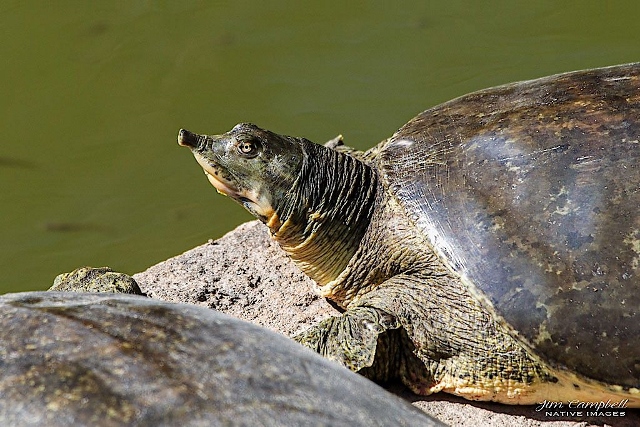by M. Kathy Raines

Don’t let the name “softshell turtle” fool you. This oddly elegant creature, though toothless, can snake its neck under and over its shell and deliver a nasty bite. Best leave these lovelies alone unless you see one walking in the path of heavy traffic.
Its spotted, serpentine neck and head, fleshy lips, underbite and protruding pig-like snout present an otherworldly appearance. The Texas spiny softshell breathes while comfortably lying in the shallows, poking its periscope-shaped, double-nostriled snout above water. Its round pupil, bordered with black, makes its eyes appear to have three pupils.
Though the pancake-shaped carapace of this softshell looks as supple and velvety as a cownose ray in a touch tank, it is neither soft nor pliable. The shell, which feels like sandpaper, is, in fact, “fairly hard,” said Clint Guadiana, Gladys Porter Zoo’s Curator of Reptiles and Amphibians, much like a “knight’s armor covered in leather.”
This lightweight shell, enclosing small lungs, helps keep these highly aquatic creatures afloat. Cartilage, not bone, flexibly hinges the carapace, rounded and wider at the rear, to its bottom shell, the plastron. Though tiny ridges adorn its shell, it lacks horny scutes, or scales.
Females, up to 17 inches long, are about double the size of males. This turtle, like a skillful kayaker, alternatively paddles with each of its webbed, three-toenailed limbs.
The Texas spiny softshell (Apalone spinifera emoryi) is one of 25 species in the softshell family, Trionychidae. Its genus name, from Latin “apalos”, means “soft”, with “on” meaning “very”. “Spina” indicates “horn”, with “fer” meaning “bearing”, for the small bumps edging its carapace. Its subspecies name “emoryi” honors a so-named officer and surveyor. Three other subspecies inhabit Texas.
A strong, fast swimmer, this softshell habitually lies in shallow mud or sand, snout above water. It can also remain submerged for hours, absorbing oxygen through its skin. Also speedy on land, it seldom strays from water but may come ashore in search of food, habitat, a mate, or nesting area.
Like all turtles—coldblooded creatures who cannot regulate body temperatures—spiny softshells bask in the sun, warming themselves and absorbing vitamin D. On a sunny winter’s day at the zoo, Guadiana has seen “fifty or more basking along the banks.”
Local softshells, unlike their midwestern cousins, do not hibernate, but they become dormant when very cold. To survive droughts, they bury themselves in mud.
Spiny softshells do not play well with others. They bite, claw and scratch. Once, Guadiana placed a female he’d caught in a tank with an alligator gar—which he realized was unwise when the softshell began “beating up” and “bullying” the much larger fish. He released the turtle to the resaca to rejoin her fellows, both gar and turtle unharmed. Guadiana emphasized that the turtle’s “first line of defense is to retreat,” a characteristic of most wild creatures.
Experts advise eager aquarists to give softshells plenty of space—a 90-gallon tank for a male, 600 for a female—and to isolate them. Apparently, these turtles are difficult to handle, messy and costly to maintain.
A spiny softshell, Guadiana said, “will absolutely consume anything it can overpower,” its diet including fish, frogs, insects, reptiles, and, occasionally, another softshell. Recently, a zoo docent was startled to see a softshell seize and devour a seagull. This turtle both ambushes and awaits prey.
Spiny softshells reach sexual maturity at between eight to ten years. During courtship, a male nudges the female’s head, swimming above her, mounting her if she is interested, not grasping her with claws, as do many turtles. The female, with hind feet, digs a six to nine-inch cavity on a sunny sandbank, laying 32 brittle, spherical, Ping-Pong ball-sized eggs. She may bear multiple clutches during nesting season, which is usually May through August.
Unlike with most turtles, genetics, rather than egg temperature, determines sex. Once eggs hatch, hatchlings struggle independently, avoiding the jaws of fish, birds, reptiles and mammals. And their parents must be wary of alligators.
These turtles thrive in local resacas. Weekends at the zoo, softshells jostle with red-eared sliders, swans and fish for treats near the orangutan exhibit, where volunteers sell “fish cones”—cones filled with fish food—for wild aquatic creatures.
Texas spiny softshells flourish, believes Guadiana, because of their “attitude”, their fierceness, and, of course, their adaptability to even urban settings. They not only inhabit Texas, but also parts of New Mexico, Arizona, Utah, California and Nevada.
Though the Texas spiny softshell is not endangered, naturalists strive to protect it. At canals edging agricultural fields, rainwater washes pesticides into waterways, endangering the fish that turtles eat. Ecologically vital, the Texas spiny softshell helps keep invasive species like tilapia and carp in check.

